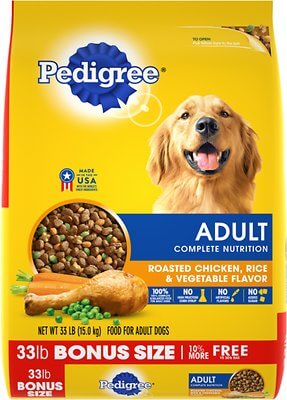
DogFoodAdvisor is reader supported See how
All reviews are 100% impartial but if you buy using links on this page, we may earn a referral fee.
Our Verdict
Pedigree dry product range is made up of 13 recipes which each receive the Dog Food Advisor’s rating, 1 star.
The table below shows each recipe in this range including our rating and the AAFCO nutrient profile: Growth (puppy), Maintenance (adult), All Life Stages, Supplemental or Unspecified.
Recipe and Label Analysis
Pedigree for Big Dogs Complete Nutrition Roasted Chicken, Rice and Vegetable Flavor was selected to represent the other products in the line for detailed recipe and nutrient analysis.
Pedigree Big Dogs Complete Nutrition Roasted Chicken, Rice and Vegetable Flavor
Estimated Dry Matter Nutrient Content
Protein
Fat
CarbsCarbohydrates
Ground whole grain corn, chicken by-product meal (source of glucosamine & chondroitin sulfate), corn gluten meal, animal fat (source of omega 6 fatty acids [preserved with bha and citric acid]), meat and bone meal, ground wheat, soybean meal, brewers rice, natural flavor (source of roasted chicken flavor), dried plain beet pulp, salt, calcium carbonate, monocalcium phosphate, potassium chloride, choline chloride, dried peas, dl-methionine, vitamin E supplement, zinc sulfate, yellow 5, dried carrots, l-tryptophan, red 40, blue 2, niacin supplement, yellow 6, d-calcium pantothenate, copper sulfate, sodium selenite, potassium iodide, vitamin A supplement, riboflavin supplement (vitamin B2), vitamin B12 supplement, thiamine mononitrate (vitamin B1), vitamin D3 supplement, pyridoxine hydrochloride
Fiber (estimated dry matter content) = 4%
Red denotes any controversial items
| Estimated Nutrient Content | |||
|---|---|---|---|
| Method | Protein | Fat | Carbs |
| Guaranteed Analysis | 22% | 10% | NA |
| Dry Matter Basis | 25% | 11% | 56% |
| Calorie Weighted Basis | 23% | 26% | 51% |
Ingredients Analysis
The first ingredient in this dog food is corn. Corn is an inexpensive and controversial cereal grain. And aside from its energy content, this grain is of only modest nutritional value to a dog.
The second ingredient is chicken by-product meal, a dry rendered product of slaughterhouse waste. It’s made from what’s left of a slaughtered chicken after all the choice cuts have been removed.
In addition to organs, this item can also include feet, beaks, undeveloped eggs and almost anything other than prime skeletal muscle.
On the brighter side, by-product meals are meat concentrates and contain nearly 300% more protein than fresh chicken.
The quality of this ingredient can vary, depending on the caliber of the raw materials obtained by the manufacturer.
The third ingredient is corn gluten meal. Gluten is the rubbery residue remaining once corn has had most of its starchy carbohydrate washed out of it.
Although corn gluten meal contains 60% protein, this ingredient would be expected to have a lower biological value than meat.
And less costly plant-based products like this can notably boost the total protein reported on the label — a factor that must be considered when judging the actual meat content of this dog food.
The fourth ingredient is animal fat. Animal fat is a generic by-product of rendering, the same high-temperature process used to make meat meals.
Since there’s no mention of a specific animal, this item could come from just about anywhere: salvaged roadkill, spoiled supermarket meat… even dead, diseased or dying cattle.
For this reason, we do not consider generic animal fat a quality ingredient.
What’s worse, this fat is preserved with BHA, a suspected cancer-causing agent.
The fifth ingredient is meat and bone meal, a dry “rendered product from mammal tissues, including bone, exclusive of any added blood, hair, hoof, horn, hide trimmings, manure, stomach and rumen contents”.1
Meat and bone meal can have a lower digestibility than most other meat meals.
Scientists believe this decreased absorption may be due to the ingredient’s higher ash and lower essential amino acid content.2
What’s worse, this particular item is anonymous. So, the meat itself can come from any combination of cattle, pigs, sheep or goats – which can make identifying specific food allergens impossible.
Even though meat and bone meals are still considered protein-rich meat concentrates, we do not consider a generic ingredient like this to be a quality item.
The sixth ingredient is ground wheat, like corn, wheat is an inexpensive and controversial cereal grain. And aside from its energy content, this grain is of only modest nutritional value to a dog. For this reason, we do not consider wheat a preferred component in any dog food.
The seventh ingredient is soybean meal, a by-product of soybean oil production more commonly found in farm animal feeds.
Although soybean meal contains 48% protein, this ingredient would be expected to have a lower biological value than meat.
And less costly plant-based products like this can notably boost the total protein reported on the label — a factor that must be considered when judging the actual meat content of this dog food.
The eighth ingredient is brewers rice. Brewers rice is a cereal grain by-product consisting of the small fragments left over after milling whole rice. Aside from the caloric energy it contains, this item is of only modest nutritional value to a dog.
From here, the list goes on to include a number of other items.
But to be realistic, ingredients located this far down the list (other than nutritional supplements) are not likely to affect the overall rating of this Pedigree product.
With five notable exceptions…
First, dried peas are a good source of carbohydrates. Plus they’re naturally rich in dietary fiber.
However, dried peas contain about 27% protein, a factor that must be considered when judging the meat content of this dog food.
In addition, we find no mention of probiotics, friendly bacteria applied to the surface of the kibble after processing to help with digestion.
Next, the minerals listed here do not appear to be chelated. And that can make them more difficult to absorb. Chelated minerals are usually associated with higher-quality dog foods.
Additionally, this recipe contains sodium selenite, a controversial form of the mineral selenium. Sodium selenite appears to be nutritionally inferior to the more natural source of selenium found in selenium yeast.
And lastly, we’re always disappointed to find artificial coloring in any pet food. That’s because coloring is used to make the product more appealing to humans — not your dog. After all, do you really think your dog cares what color his food is?
Nutrient Analysis
Based on its ingredients alone, Pedigree Dog Food looks like a below-average dry product.
The dashboard displays a dry matter protein reading of 25%, a fat level of 11% and estimated carbohydrates of about 56%.
As a group, the brand features an average protein content of 26% and a mean fat level of 12%. Together, these figures suggest a carbohydrate content of 55% for the overall product line.
And a fat-to-protein ratio of about 46%.
Which means this Pedigree product line contains…
Near-average protein. Below-average fat. And above-average carbs when compared to a typical dry dog food.
When you consider the protein-boosting effect of the corn gluten meal, soybean meal and dried peas, this looks like the profile of a kibble containing just a moderate amount of meat.
Pedigree Dog Food Recall History
The following automated list (if present) includes all dog food recalls related to Pedigree through July 2024.
You can view a complete list of all dog food recalls since 2009 here.
Our Rating of Pedigree Dog Food
Pedigree is a grain-inclusive dry dog food using a moderate amount of named and unnamed meat and bone meals as its dominant source of animal protein, thus earning the brand 1 star.
Compare Pedigree Dog Food
How does Pedigree compare with The Dog Food Advisor's most recommended brands?
Sources
A Final Word
The Dog Food Advisor does not accept money, gifts, samples or other incentives in exchange for special consideration in preparing our reviews.
However, we do receive a referral fee from online retailers (like Chewy or Amazon) and from sellers of perishable pet food when readers click over to their websites from ours. This helps cover the cost of operation of our free blog. Thanks for your support.
For more information, please visit our Disclaimer and Disclosure page.








